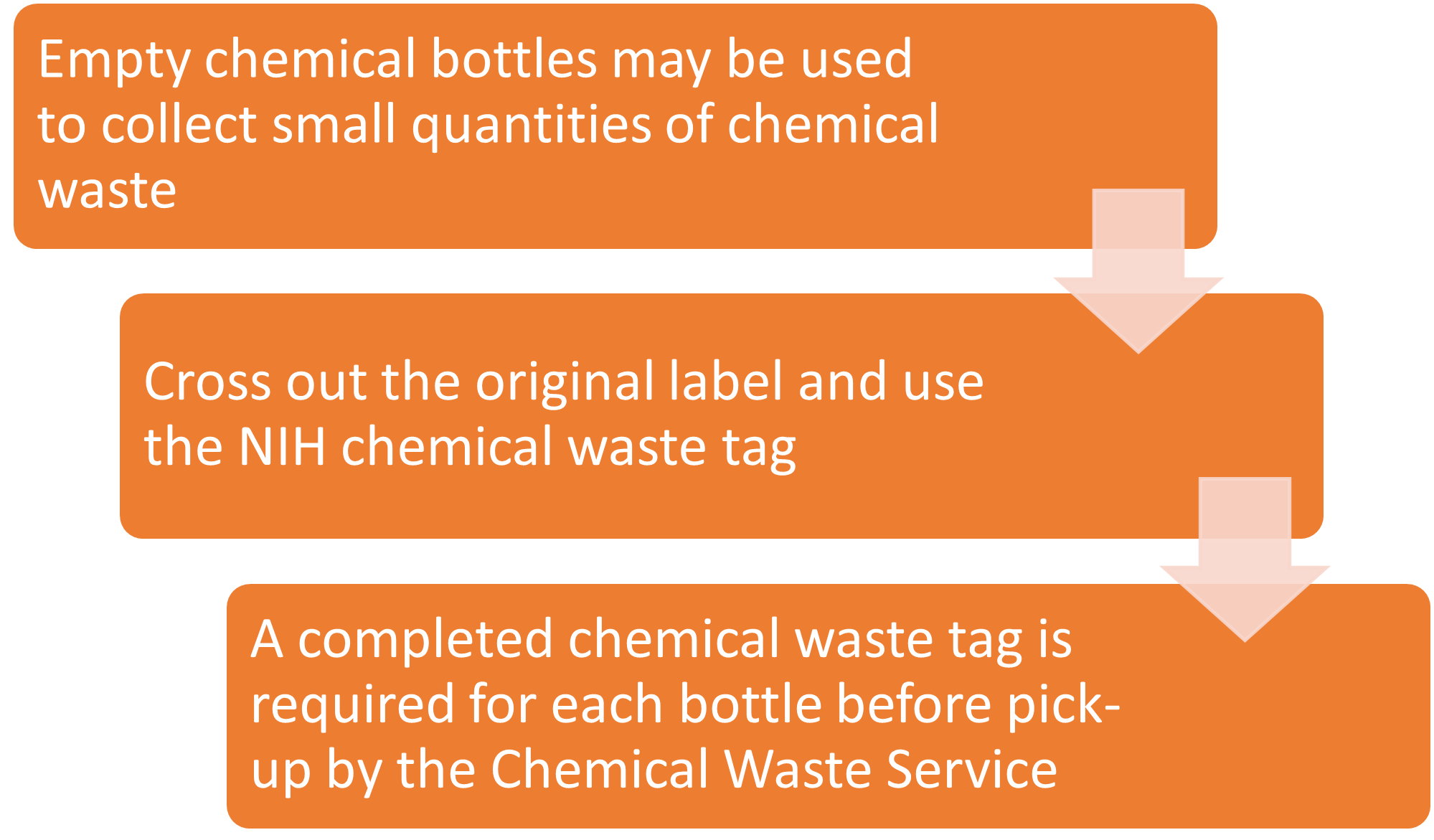Can I place my waste containers for pickup in the hallway?
No. NIH must maintain environmental compliance. After communication has occurred on the day of scheduled pickup between the waste generator and the waste collection contractor, researchers can place waste containers near the access door to the laboratory in secondary pans.
Will my containers be picked up if I am not able to receive a call or e-mail for some reason?
Yes. If no call or e-mail communication is established, chemical contractors will still attempt to pick up from your lab.
Can I schedule a specific day for my waste containers to be picked up?
Yes. Call Chemical Waste Services at 301-496-4710, Monday-Friday to schedule a pickup.
Once generated, where is chemical waste stored?
Waste is stored at the point of generation. Do not put waste containers in the hallway or other public locations. Do not transport waste across the hallway to another location for storage.
Can chemical waste containers remain open during business or working hours?
No, ensure that all chemical waste containers are closed securely except at the time waste is added.
Is a funnel available for carboys?
Yes, Chemical Waste Services provide NIH-approved funnels with lids. Close the lid when not adding waste to the container.
Can I use acronyms or brand names on the NIH Chemical Waste Tag?
No, all major constituents and hazardous components must be identified by chemical name.
How long can I keep a chemical waste container stored in my lab?
Chemical waste must be picked up within 60 days of the accumulation start date.
Do I have to follow the NIH Drain Discharge Guidance?
Yes, all NIH personnel are forbidden from discarding waste to the sanitary sewer, except where authorized by the NIH Drain Discharge Guidance.
Do I have to use or complete the NIH Waste Tag?
Yes, the front of the tag must be filled out entirely as soon as the first drop of waste is added to the container.
Do empty reagent bottles require the NIH Waste Tag?
No, call Chemical Waste Services to request collection totes for the empty bottles.
How are empty reagent bottles disposed of by the NIH?
All empty bottles (glass, plastic and metal) that previously contained chemicals (liquid or solid) or buffer saline solutions can be recycled if collected by Chemical Waste Services. Please leave the cap on the empty bottle.
Can PBS or Media empty bottles be recycled in commingled bins?
No, both are reagent bottles. Call Chemical Waste Services to request collection totes for the empty bottles.
Who is responsible for collecting battery waste?
All batteries must be collected for recycling by Chemical Waste Services, including non-UPS batteries contained within equipment.
Will Chemical Waste Services remove lead acid batteries from servers or casings?
No, Chemical Waste Services only handles the individual batteries. The requestor is responsible for separating lead acid batteries from equipment or casings.
Can I collect chemical waste in empty bottles or containers?
Yes, chemical waste can be collected in empty bottles with the following guidance:

Can I mix mercury or mercury-containing materials with any other waste?
No, do not mix these materials with any other waste.
What is mixed or multihazardous waste?
Multihazardous waste contains two or more of the following: radioactive material, infectious agent(s), or hazardous chemical(s). One type of multihazardous waste is mixed waste, which contains both a hazardous component and radioactive material regulated by the NRC.
Who should I call for my multihazardous waste?
You should call Radioactive Waste Services at 301-496-4451.
What is the waste accumulation start date and when does it begin?

Do I have to separate tissue from formalin/aldehyde solutions?
Yes, separate the tissue from the formalin or formaldehyde solution; dispose of the liquid through Chemical Waste Services; dispose of the tissue using an MPW box.
Do all waste containers require a secondary containment spill pan?
Only liquid waste containers require a secondary containment spill pan.
How do I procure or use mercury products in the lab?
You must complete
NIH Form 2936.
What types of waste cannot go down the drain?
Oxidizers
| Radioactive Waste | Phenols | Acids |
| Explosives | Reactives | Toxic Substances | Danger to Aquatic Life |
| Heavy Metals | Bases | Toxic by Inhalation | Flammable Material |